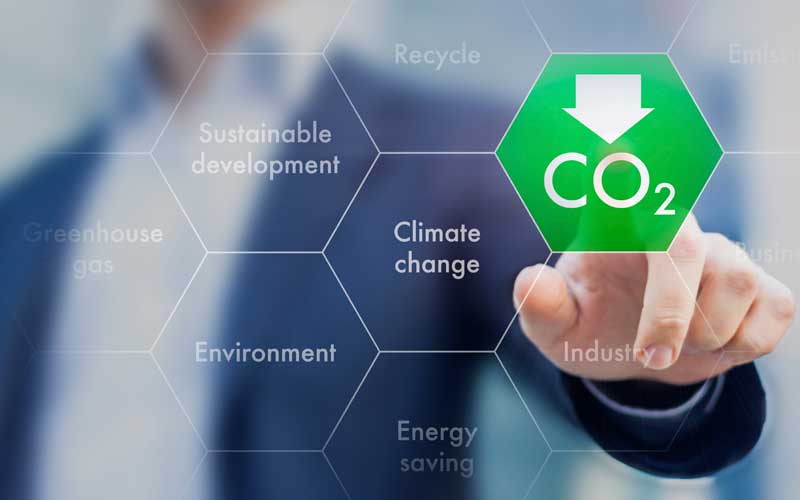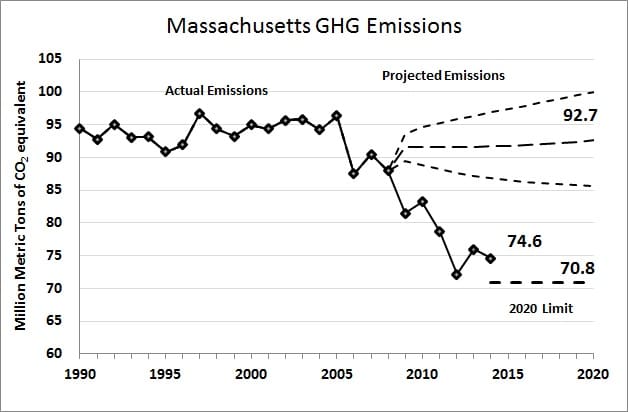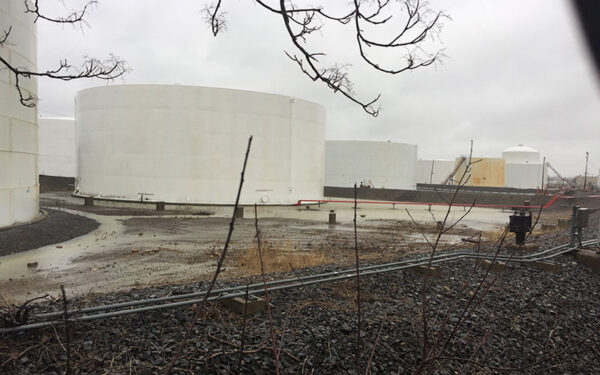
Last week Massachusetts finalized and released the state’s latest inventory of its statewide emissions of climate-damaging greenhouse gases (GHGs). The final numbers indicate that in 2014, the Commonwealth released the equivalent of 74.6 million tons of carbon dioxide into the atmosphere, which is a slight improvement over 2013, when emissions totaled about 76 million tons.
That’s good news and is far better than the increase in climate-damaging emissions we saw the year before. But a single year of slightly lower emissions isn’t good enough.
We Don’t Just Need Fewer Emissions, We Need No Emissions
In order to meet the state’s legal obligation under its nation-leading climate law, the Global Warming Solutions Act (GWSA), our energy system – electricity, transportation, building services, industrial processes – needs to be almost carbon free by 2050. That is entirely possible – it’s something we can do both technically and affordably. But make no mistake: It will take serious work and attention to make it happen . . . and we have to do that work fast.
There is no “silver bullet” solution to climate change – it takes time and sustained effort from all sectors of our economy to make the transformational changes the law, science, and a healthy climate require. But the longer we wait to attack the problem comprehensively, the harder and more expensive it will be – and the bigger the climate change–induced impacts we will face in the meantime.
New Bill Would Create Roadmap to Reach 2050 Emissions Goals
The GWSA sets two mandated benchmarks for the state to reduce its emissions: The first deadline is 2020, by when emissions must be reduced 20 percent below 1990 levels (despite this year’s progress, we still have a ways to go to meet that goal). The next is 2050, when those cuts must reach 80%. The GWSA doesn’t currently mandate what should happen in the 30-year gap between those two benchmarks, nor is there a legal backstop to prevent emissions from creeping back up in, say, 2025, so long as that ultimate 2050 goal is met. (And creeping back up is a very real possibility, as the chart below shows.)
That’s why CLF has joined with Representative Frank Smizik (D – 15th Norfolk/Brookline) and Senator Marc Pacheco (D – 1st Plymouth/Bristol/Taunton) to support key new legislation here in Massachusetts: the Global Warming Solutions Implementation Act (H.2149 / S.479). The goal of the Act is to both require and enable the type of comprehensive, cross-sector analysis and solution development we need to get us from the GWSA’s upcoming 2020 mandated limit to the 2050 goal line.
And it would do this through a few simple, but also clear and strong, provisions:
First, it would require the state to take the next year or two to map viable pathways that can get us from 2020 to 2050. This would involve analysis to understand how to coordinate, year-by-year, the influx of new technologies that will slash our emissions over the next 30 years. The pathways will take into account new renewable energy sources like wind and solar as well as the growing fleet of electric and other zero-emission vehicles. It will also consider emissions reductions from increasing energy efficiency and transitioning homes and businesses from fossil-fuel-burning furnaces and stoves to electric heat pumps and ovens.
Then, armed with that data, the state would be required to set realistic and achievable emissions limits for 2030 and 2040, each of which would be legally enforceable under the GWSA (just like the current benchmark years).
As a final step (these things do take some time to do, right!), with new enforceable limits in hand, the state would have to issue a comprehensive set of “2050 regulations” that can guide our markets and behavior to 2050 success. This would be a big effort – the development of important new programs and markets like economy-wide carbon pricing (a carbon fee or cap-and-trade), major transportation initiatives and investments, and a significantly revised building code, among other possible initiatives.
To ensure the dedicated women and men in our state energy and environmental agencies have the resources to get the job done efficiently and effectively, the Global Warming Solutions Implementation Act would use an innovative mechanism to increase funding for those agencies. Mirroring a mechanism that has been used with great success for a few years now in California, the Act would authorize the Department of Environmental Protection to impose a moderate carbon pollution fee on the 200 or so biggest polluters in the state in proportion to their annual carbon emissions, with all money earmarked and protected solely for positions and programs necessary for implementing the GWSA.
Massachusetts Leading the Way in New England
The passage of the Global Warming Solutions Act in 2008 made Massachusetts a leader in New England – and the country – in addressing the threats posed by climate change. This new bill gives the Commonwealth the chance to lead once again. Reaching our climate goals was never going to be easy, but, with foresight and planning, it is possible to do effectively, efficiently, and affordably. And the risks of doing nothing – or of waiting too long to take meaningful action – are far too high to be ignored.




